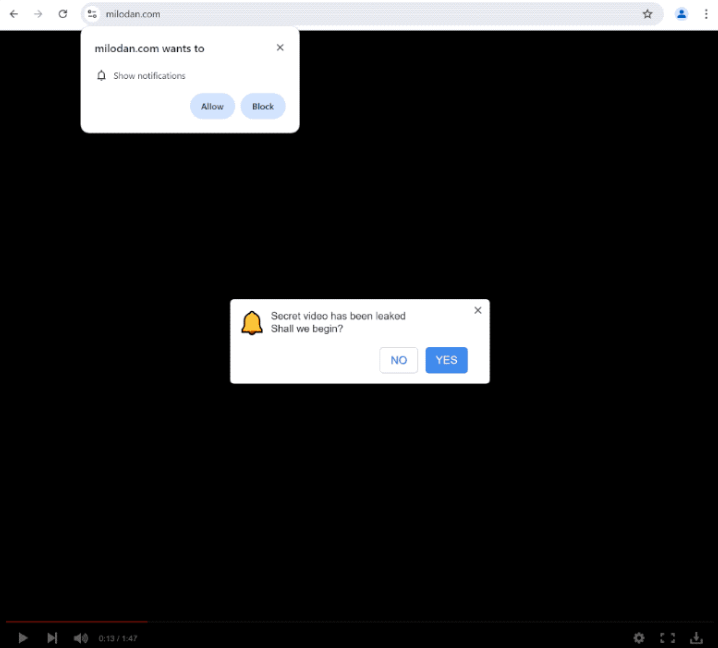milodan.com is a generic scam website that will try to trick you into allowing ads on your desktop. It misuses a legitimate browser feature to do this, which is why you will see a browser alert saying “milodan.com wants to show notifications” when you get redirected to the site. If you click “Allow”, you will authorize the site to show you ads.
milodan.com does not have any content on it. It only shows a fake video player and a message saying a secret 18+ video has been leaked. The message implies that to view the video, you need to click “Allow” on the “milodan.com wants to show notifications” alert. If you click “Allow”, you will allow the site to show notifications directly to your desktop. Legitimate sites show legitimate notifications, but milodan.com will simply spam ads. If you have given it permission, don’t interact with those ads because they could expose you to harmful content, such as scams and malware.
The “show notifications” feature that milodan.com is misusing does have legitimate uses. You can give sites permission to show notifications as long as they are safe. You may even find the feature to be useful in some cases. For example, if there’s a particular website you frequent, and you want to see more of its content, you can give it permission.
It’s not difficult to revoke a site’s permission to show notifications as long as you can navigate your browser’s settings. If you need assistance with that, you can use the instructions provided at the end of the report.
What triggers redirects to sites like milodan.com
In most cases, users are redirected to sites like milodan.com because they do not use an adblocker program while browsing high-risk websites. Many websites try to expose users to as much advertisement content as possible, and that means they spam ads and trigger redirects no matter what users do on a site. Sites with pornographic or pirated content are particularly guilty of this. Fortunately, a decent adblocker program easily blocks both ads and redirects.
Redirects might also be a sign of an adware infection. It’s not a dangerous infection but the ads it will expose you to will be very annoying. Adware and similar infections get installed via what’s known as the free software bundling method. The way it works is adware can be attached to free programs as an extra offer. These offers are permitted to be installed without needing explicit permission. The method is quite frowned upon, and it’s not uncommon for programs that use it to be detected as potentially unwanted by anti-virus programs.
The additional offers are always optional, and preventing their installations is not difficult. When installing a program, make sure to use Advanced (Custom) settings. The installation window will recommend you use Default settings but if you follow this advice, all of the added offers will be authorized to install automatically. Advanced settings, on the other hand, will make the offers visible. Those settings will also give you the option to deselect all of them. All you need to do is uncheck the boxes.
Do not allow extra offers to be installed, even if the offers initially seem useful. If you allow these unwanted installations, you will fill your computer with useless junk that can be tricky to get rid of later on. It’s much easier to just uncheck a couple of boxes when installing free programs.
How to stop milodan.com redirects
It’s strongly recommended to scan your computer with an anti-virus program to check for an adware infection if you are redirected to milodan.com and similar sites more than once. Adware can sneak in without you noticing, so redirects may be a sign of its presence. Use an anti-virus program because adware infections can be tricky to get rid of manually. You also need to have a good adblocker.
If you have given milodan.com permission to show you notifications, you can easily evoke it in your browser’s settings. If you need help to remove milodan.com from the list of sites that have permission, we have provided directions below.
- Mozilla Firefox: Open the menu (the three bars at the top-right corner), click Options, then Privacy & Security. Scroll down to Permissions, press Settings next to Notifications, and remove milodan.com and any other questionable websites from the list. It’s possible to permanently turn off push notification requests by checking the “Block new requests asking to allow notifications” box in the same Notifications settings.
- Google Chrome: Open the menu (the three dots top-right corner), then Settings, then Privacy and security, then Site Settings. Click on Notifications under Permissions, and remove milodan.com and any other questionable websites from the list. It’s possible to permanently turn off push notification requests by toggling off “Sites can ask to send notifications”.
- Microsoft Edge: Open the menu (the three dots top-right corner), then Settings, then Cookies and site permissions, then Notifications. Review which sites have permission and remove milodan.com and any other questionable websites from the list. It’s possible to permanently turn off push notification requests by toggling off “Ask before sending”.
Site Disclaimer
2-remove-virus.com is not sponsored, owned, affiliated, or linked to malware developers or distributors that are referenced in this article. The article does not promote or endorse any type of malware. We aim at providing useful information that will help computer users to detect and eliminate the unwanted malicious programs from their computers. This can be done manually by following the instructions presented in the article or automatically by implementing the suggested anti-malware tools.
The article is only meant to be used for educational purposes. If you follow the instructions given in the article, you agree to be contracted by the disclaimer. We do not guarantee that the artcile will present you with a solution that removes the malign threats completely. Malware changes constantly, which is why, in some cases, it may be difficult to clean the computer fully by using only the manual removal instructions.
